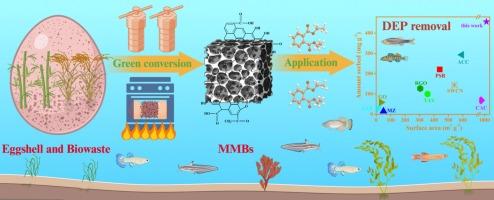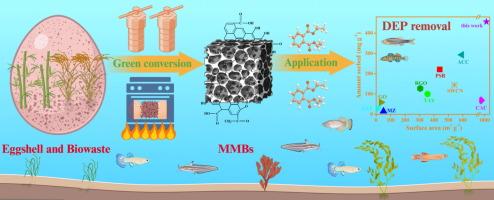由农林渣和蛋壳共解制备用于去除水中增塑剂的微介孔生物炭
IF 9
1区 工程技术
Q1 ENGINEERING, CHEMICAL
引用次数: 0
摘要
来自农林生物废弃物的多孔碳质材料不仅具有独特的组成和结构,提供了高度可达的表面积和许多暴露的活性位点,而且具有稳定的回收性能,因此对环境修复具有很大的兴趣。然而,寻找一种绿色和低成本的方法来制备具有所需成分和结构的多孔生物炭一直是一个挑战。在此,我们报道了一种绿色、简单的碳化方法,用于低成本合成微介孔生物炭(MMBs)。在不使用化学活化剂的情况下,MMBs的比表面积和孔体积分别达到1949 m2 g−1和1.21 cm3 g−1。形成了类石墨结构和丰富的含氧表面官能团。高碳化温度(≥800 °C)对蛋壳的分解至关重要,并对孔隙的打开起作用。孔隙填充对污染物具有良好的吸附去除效果。邻苯二甲酸二乙酯的吸附量达到456 mg g−1。氢键和π -π堆积以及传质控制了吸附速率。这种新颖的合成方法提供了一种简单的方法来制备具有各种潜在环境和能源应用优势的碳质材料,如废水处理、气体捕获、能量储存和转换。本文章由计算机程序翻译,如有差异,请以英文原文为准。


Micro-mesoporous biochars derived from the copyrolysis of agroforestry residue and eggshell for removing plasticizer from water
Porous carbonaceous materials derived from agroforestry biowaste are of great interest for environmental remediation because of not only their unique composition and structure, which provide a highly accessible surface area and consequently many exposed active sites but also their stable recycling performance. However, finding a green and low-cost way to prepare porous biochars with the desired composition and structure has been challenging. Herein, we report a green and simple carbonization method for the low-cost synthesis of micro-mesoporous biochars (MMBs) using biowaste and eggshell. Without chemical activation agents, the specific surface area and pore volume of the MMBs reached 1949 m2 g−1 and 1.21 cm3 g−1, respectively. Graphite-like structures and abundant O-containing surface functional groups formed. A high carbonization temperature, ≥ 800 °C, was crucial for eggshell decomposition and played a role in pore opening. Pore filling led to excellent sorption removal of pollutants. The sorption amount for diethyl phthalate reached 456 mg g−1. Hydrogen bonding and π–π stacking, as well as mass transfer, controlled the sorption rate. This novel synthetic method provides a simple way to prepare carbonaceous materials with advantageous properties for a variety of potential environmental and energy applications, such as wastewater treatment, gas capture, and energy storage and conversion.
求助全文
通过发布文献求助,成功后即可免费获取论文全文。
去求助
来源期刊

Separation and Purification Technology
工程技术-工程:化工
CiteScore
14.00
自引率
12.80%
发文量
2347
审稿时长
43 days
期刊介绍:
Separation and Purification Technology is a premier journal committed to sharing innovative methods for separation and purification in chemical and environmental engineering, encompassing both homogeneous solutions and heterogeneous mixtures. Our scope includes the separation and/or purification of liquids, vapors, and gases, as well as carbon capture and separation techniques. However, it's important to note that methods solely intended for analytical purposes are not within the scope of the journal. Additionally, disciplines such as soil science, polymer science, and metallurgy fall outside the purview of Separation and Purification Technology. Join us in advancing the field of separation and purification methods for sustainable solutions in chemical and environmental engineering.
 求助内容:
求助内容: 应助结果提醒方式:
应助结果提醒方式:


